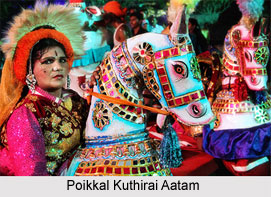Traditional Dance with a Dummy Horse Tied Around the Waist!
Poikkal Kuthirai Aatam is performed bearing a lightweight dummy horse around the dancer’s waist.
Folk arts typically closely represent the culture and heritage of a region. In Tamil Nadu, the dance form of Poikkal Kuthirai Aatam is one such art. Also called Puravai Aatam, this is one of the oldest dance forms of the state that has been the birthplace for various innovative arts.As a community art, this dance is popular in villages across Tamil Nadu and has blended with the day-to-day life of the people. Unlike Karagattam and Kavadi Aatam, both religious dances, Poikkal Kuthirai is mostly performed as an entertainment during festivals. It may also be performed as part of religious celebrations; for instance, in honor of Ayyanar, the Hindu idol that is worshipped to protect the village.
Poikkal Kuthirai Aatam is performed bearing a lightweight dummy horse around the dancer’s waist. This dance may be called Puravi Naatiyam (Horse Dance), Poi Kuthirai (False Horse) and Marakkaladal (Wooden Leg Dancing). It is also popular in states other than Tamil Nadu. The dance is known as Saithikoda in Orissa, Theelu Gurram in Andhra Pradesh, Kachikoti in Rajasthan and Kuthikali in Kerala.
History:
It is said that Poikkal Kuthirai Aatam was introduced to Tamil Nadu by the Maratha kings. There are also references to this art form in early Tamil epics. The dance is one of the 11 dances performed by Madhavi, a character in Silappadikaram. This work was written in the 2nd century and is one of the ancient epics of the Tamil language. References to Poikkal Kuthirai Aatam can also be found in the epic Tholkaapiam. In one section, the heroine’s parents ban the marriage between their daughter and her lover. The hero dons a horse-like structure made up of maple leaves and starts protesting in the streets to marry the girl. Mentions in these epics indicate that this art form originated many centuries ago.
There is a legend that Goddess Durga used to perform this dance. To take revenge, her enemies disguised themselves as poisonous snakes and scorpions, and planned to bite her while dancing. Durga was aware of their plan and for self-protection she tied wood around her legs and danced. As a result of heavy dance steps made by her, her enemies died. This gave the dance the name of Marakkaladal, or Wooden Leg Dancing. Later, the dance was renamed Poikkal Kuthirai.
Aesthetics:
The dummy horse is typically made up of jute, cardboard, paper and glass. It contains a hole into which the dancer can fit. The legs of the horse are, of course, the legs of the dancers, but it looks as if the dancer is sitting on a horse. The dancers also don wooden legs that sound like the horse’s hooves. The dummy horse is adorned with colorful skirts that swing around with the movements of the dancers.
This dance requires extensive training and skill as the wooden legs constrict one’s movement and are also heavy. In some places, such as Madurai, there is a practice of performing the dance without wooden legs and they dance barefoot, wearing only anklets.
This dance is typically performed in oorvalam, meaning procession, which covers all the areas surrounding the temple during festivals. Dancers often portray kings and queens and sport swords. Sometimes, the dance is performed by groups of eight or ten dancers standing in circles or lines.
Poikkal Kuthirai Aatam is performed to the accompaniment of Naiyandi Melam. A Naiyandi Melam musical ensemble typically includes two nathaswarams (wind-pipes), one sudhipetti, and one thaalam, and several drums played with drum sticks such as thavils, pambai, kidumutti or sinukuchatti. This is the style followed in Kongunadu region of Tamil Nadu. In southern parts of the state, an urumi—a drum with two conical heads—is also used along with the other instruments.
Popularity:
Poikkal Kuthirai Aatam is famous all over Tamil Nadu and most parts of India.
|
-Tamilan



 Poikkal Kuthirai Aatam Dance also known as the Dummy Horse Dance, is famous as the folk dance of
Poikkal Kuthirai Aatam Dance also known as the Dummy Horse Dance, is famous as the folk dance of
No comments:
Post a Comment